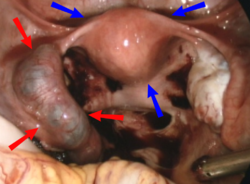This article needs more reliable medical references for verification or relies too heavily on primary sources .(February 2019) |  |
| Hematosalpinx | |
|---|---|
 | |
| Laparoscopic view, looking from superiorly to inferiorly in the peritoneal cavity which has been pumped up with carbon dioxide gas to visualize the uterus (marked by blue arrows). On the left fallopian tube there is an ectopic pregnancy and hematosalpinx (marked by red arrows). The right tube is normal. | |
| Specialty | Urology |
Hematosalpinx (sometimes also hemosalpinx) is a medical condition involving bleeding into the fallopian tubes.